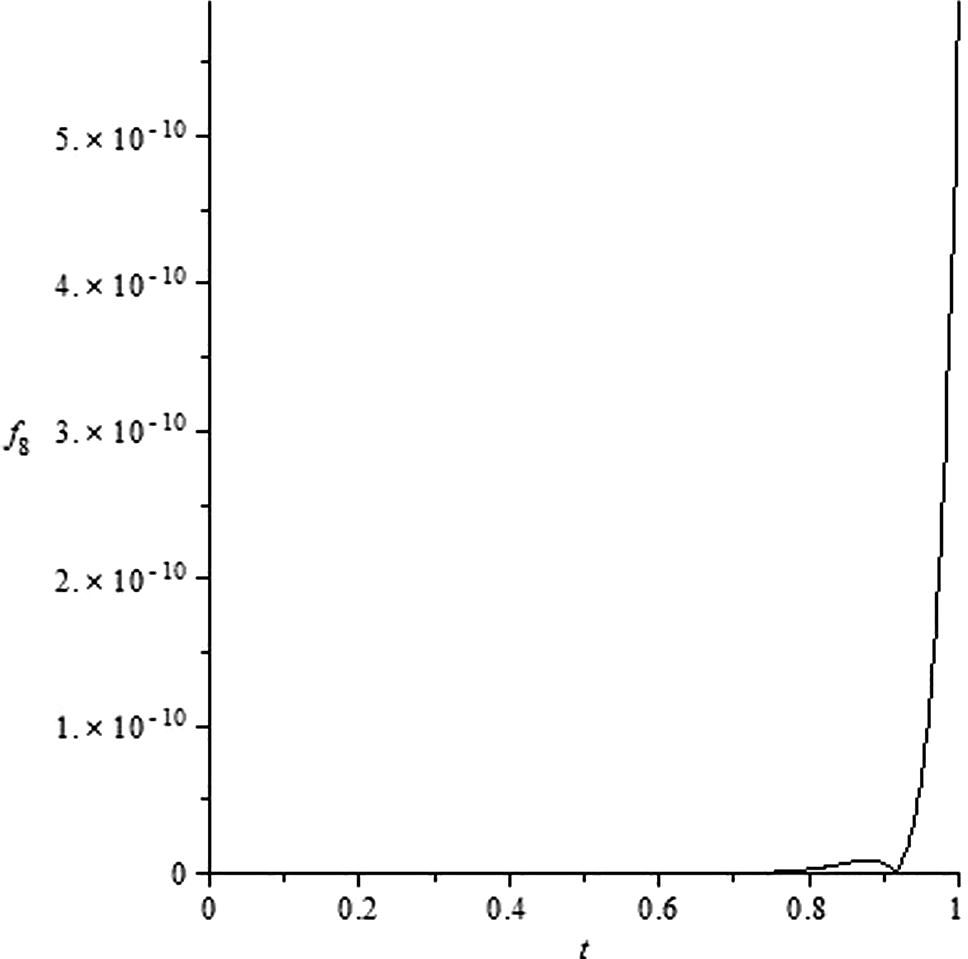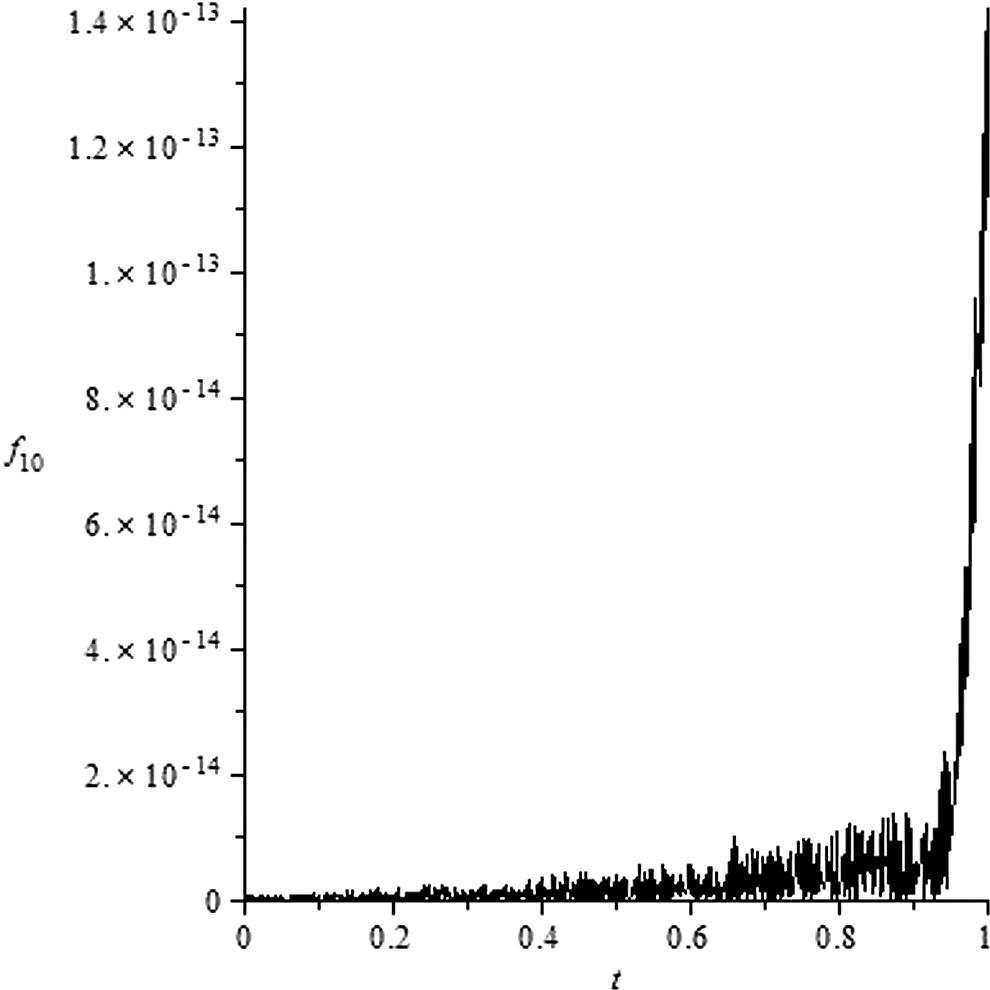Translate this page into:
Challenge in the variational iteration method – A new approach to identification of the Lagrange multipliers
*Tel.: +86 0832 2341101 wuguocheng2002@yahoo.com.cn (Guo-Cheng Wu)
-
Received: ,
Accepted: ,
This article was originally published by Elsevier and was migrated to Scientific Scholar after the change of Publisher.
Available online 20 December 2012
Peer review under responsibility of King Saud University.
Abstract
The variational iteration method has been one of the most often used analytical methods in the past ten years. However, the success of the method mainly depends upon accurate identifications of the Lagrange multipliers. This study suggests a universal way to identify the multiplier which is a simple but effective approach by implementing Laplace transform. The Adomian series and the Pade technique are also employed to accelerate the convergence of the variational iteration algorithm. An example is given to elucidate the solution process and reliability of the solution.
Keywords
Variational iteration method
Adomian decomposition method
Laplace transform
Symbolic computation
1 Introduction
From the Lagrange multiplier method (Inokuti et al., 1978), the variational iteration method (VIM), which was first proposed by (He, 1998, 1999) and systematically elucidated in (He and Wu, 2007), has been worked out over a number of years by numerous authors. Since there is no need to handle nonlinear terms in an equation and it results in approximate solutions with high accuracies, the analytical method caught much attention in the past ten years, and it has matured into a relatively fledged theory thanks to the efforts of many researchers, notably (Abbasbandy, 2007; Noor and Mohyud-Din, 2008; Xu, 2009; Geng, 2010; Jafari and Khalique, 2012) to mention only a few. For a relatively comprehensive survey on the concepts, theory and applications of the method, readers are referred to review articles (He and Wu, 2007; He, 2012).
Recently, Laplace transform is adopted in some famous analytical methods (e.g., the Laplace Adomian decomposition method (LAPM) (Tsai and Chen, 2010; Zeng and Qin, 2012) and the homotopy perturbation method (Javidi and Raji, 2012)) to simplify the solution process and improve solution's accuracy. However, their applications mainly limit to the applications in differential equations with constant coefficients. Though the VIM can deal with such problems, the identification of the Lagrange multiplier is complex if not impossible. To solve the problem, the VIM is reconstructed and Laplace transform is adopted in simple and accurate identification of the multipliers.
2 A novel modification of the variational iteration method
We use the following general nonlinear equation to illustrate its basic idea of the VIM:
The basic character of the method is to construct the following correction functional for Eq. (1)
The Lagrange multiplier can be identified as (He and Wu, 2007)
Now considering the system (1) with variable coefficients and assuming the linear term as
-
Take the Laplace transform on (1), then the iteration formula becomes
(5)where U(s) is Laplace transform of u(t) and s is a complex variable. -
Consider the terms and L(N[un]) as restricted variations. Make Eq. (5) stationary with respect to Un
(6)From Eq. (6), we can determine the Lagrange multiplier as follows -
The variational iteration formula is obtained through the inverse Laplace transform L−1: where the initial iteration value can be determined as
-
Let and apply the Adomian decomposition method (ADM) (Adomian, 1994) to expand the term N[u] as Then the iteration formula reads where Aj is the famous Adomian decomposition series. A detailed review of the ADM can be found (See Duan et al., 2012).
-
Employ the Pade-technique (Baker and Graves-Morris, 1996) to accelerate the convergence of un.
Remarks:
If ai is a constant, the presented algorithm reduces to Tsay and Chen's LAPM. On the other hand, since the VIM allows the terms with variable coefficients as restricted variations, as a result, the modified VIM here is more flexible and general here.
This idea can also be extended to the fractional calculus of variations (Baleanu and Trujillo, 2008,2010). For the VIM in the fractional differential equations, the Lagrange multipliers can be determined readily from Laplace transform. Readers who feel interested in the method are referred to the recent development (Wu, 2012a, b, c).
Consider the following differential equations with a variable coefficient as an example
Considering the terms L[2tu] and L[u3] are restricted variations, take the classical variation operator on both sides of (9)
As a result, a Lagrange multiplier can be determined as
Substituting (10) into (9), one can obtain
With symbolic computation, we can derive the following approximate solutions
Now apply the Pade technique to u8 and u10 and denote the results by
and
Define the residual value function as

Curve of the residual value f8.

Curve of the residual value f10.
On the other hand, we also can have the following variational iteration formula for (7) if only the term is included in the calculus of variations.
4 Conclusions
The VIM has been extensively used for solving various differential equations. The critical step of the method is to identify the Lagrange multipliers through calculus of variations. In this study, the VIM is improved with Laplace transform and the Adomian series. Compared with the classical VIM, the modified version method has following merits: (a) the Lagrange multipliers can be readily obtained in a more straightforward way; (b) the initial iteration value can be determined universally; (c) The method is also powerful to solving differential equations with variable coefficients. The error analysis and higher order approximate solutions of the nonlinear oscillator illustrate the method's efficiencies and high accuracies.
References
- A new application of He's variational iteration method for quadratic Riccati differential equation by using Adomian's polynomials. J. Comput. Appl. Math.. 2007;207(1):59-63.
- [Google Scholar]
- Solving Frontier Problems of Physics: The Decomposition Method. Kluwer Academic Publishers; 1994.
- Padé Approximants. Cambridge University Press; 1996.
- On exact solutions of a class of fractional Euler–Lagrange equations. Nonlinear Dyn.. 2008;52(4):331-335.
- [Google Scholar]
- A new method of finding the fractional Euler–Lagrange and Hamilton equations within Caputo fractional derivatives. Commun. Nonlinear Sci. Numer. Simul.. 2010;15(5):1111-1115.
- [Google Scholar]
- A review of the Adomian decomposition method and its applications to fractional differential equations. Commun. Fract. Calc.. 2012;3(2):73-99.
- [Google Scholar]
- A modified variational iteration method for solving Riccati differential equations. Comput. Math. Appl.. 2010;60(7):1868-1872.
- [Google Scholar]
- Approximate analytical solution for seepage flow with fractional derivatives in porous media. Comput. Methods Appl. Mech. Eng.. 1998;167(1–2):57-68.
- [Google Scholar]
- Variational iteration method – a kind of nonlinear analytical technique: some examples. Int. J. Nonlinear Mech.. 1999;34(4):699-708.
- [Google Scholar]
- Variational iteration method: new development and applications. Comput. Math. Appl.. 2007;54(7–8):881-894.
- [Google Scholar]
- Asymptotic methods for solitary solutions and compactons. Abstr. Appl. Anal.. 2012;2012:916793.
- [Google Scholar]
- General use of the Lagrange multiplier in nonlinear mathematical physics. In: Nemat-Nasser S., ed. Variational Methods in the Mechanics of Solids. NY: Pregman Press; 1978. p. :156-162.
- [Google Scholar]
- Homotopy perturbation and variational iteration methods for solving fuzzy differential equations. Commun. Fract. Calc.. 2012;3(1):38-48.
- [Google Scholar]
- Combination of Laplace transform and homotopy perturbation method to solve the parabolic partial differential equations. Commun. Fract. Calc.. 2012;3(1):10-19.
- [Google Scholar]
- Variational iteration method for solving higher-order nonlinear boundary value problems using He's polynomials. Int. J. Nonlinear Sci. Numer. Simul.. 2008;9(2):141-156.
- [Google Scholar]
- An approximate analytic solution of the nonlinear Riccati differential equation. J. Franklin Inst.. 2010;347(10):1850-1862.
- [Google Scholar]
- Laplace transform overcoming principle drawbacks in application of the variational iteration method to fractional heat equations. Therm. Sci.. 2012;16(4):1257-1261.
- [Google Scholar]
- Variational iteration method for solving the time-fractional diffusion equations in porous medium. Chin. Phys. B. 2012;21(12):120504.
- [Google Scholar]
- Applications of the variational iteration method to fractional diffusion equations: local versus non-local ones. Int. Rev. Chem. Eng.. 2012;4(5):505-510.
- [Google Scholar]
- The variational iteration method for fourth order boundary value problems. Chaos, Solitons Fractals. 2009;39(3):1386-1394.
- [Google Scholar]
- The Laplace–Adomian–Pade technique for the seepage flows with the Riemann–Liouville derivatives. Commun. Fract. Calc.. 2012;3(1):26-29.
- [Google Scholar]







